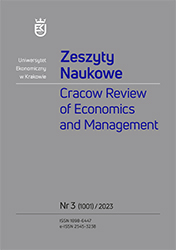The Marketing Activities of Cultural Institutions as a Response to the Development of Streaming Platforms and the Virtualisation of Cultural Participation
DOI:
https://doi.org/10.15678/ZNUEK.2023.1001.0301Keywords:
marketing, cultural institutions, streaming platforms, cultural participation, new mediaAbstract
Objective: To show trends and new challenges for the marketing of cultural institutions in the context of virtualising cultural participation and the development of streaming platforms.
Research Design & Methods: The paper shows trends and new challenges for the marketing of cultural institutions seeking to virtualise cultural participation and develop streaming platforms. The research procedure triangulates quantitative and qualitative research methods. It included literature studies, an analysis of the results of a survey conducted in 2022 on a sample of 1,019 Poles, and semiotic analyses.
Findings: The values obtained from watching films in a cultural institution – for example, the cinema, is different from those streaming platforms offer their users. Watching movies via streaming platforms does not fully replace watching movies in cinemas, because it creates a completely different context for the reception of the artwork.
Implications / Recommendations: The considerations presented in the paper indicate that virtualisation and hybridity in the sphere of culture should not so much mean transferring directly developed solutions to the Internet, but rather creating new, innovative ones, referring to the language of new media. At the same time, the hybrid nature of cultural events – their being provided now through classic and online means – strengthens both the events themselves and the value they offer consumers.
Contribution: The main contribution is a presentation of the correlations between the perception of participation in culture and the reasons for giving up going to the cinema.
References
Bonacini E., Giaccone S. C. (2022), Gamification and Cultural Institutions in Cultural Heritage Promotion: A Successful Example from Italy, “Cultural Trends”, vol. 31(1), https://doi.org/10.1080/09548963.2021.1910490.
Budnik A. (2021), Festiwale i nagrody literackie w dobie pandemii – smutna konieczność czy szansa na zmiany? (in:) Badania w sektorze kultury. Przyszłość i zmiana, A. Konior, O. Kosińska, A. Pluszyńska (eds), Wydawnictwo Attyka, Kraków.
Christie I. (2012), A Disturbing Presence? Scenes from the History of Film in the Museum (in:) Film, Art, New Media: Museum without Walls?, ed. A. Dalle Vacche, Palgrave Macmillan, London.
Colbert F. (2007), Marketing Culture and the Arts, HEC, Montreal.
Denzin N. K. (2017), The Research Act. A Theoretical Introduction to Sociological Methods, Routledge, New York.
Diggles K. (1986), Guide to Arts Marketing: The Principles and Practice of Marketing and They Apply to the Arts, Rhinegold Publishing, London.
Ekonomou T., Vosinakis S. (2018), Mobile Augmented Reality Games as an Engaging Tool for Cultural Heritage Dissemination: A Case Study, “Scientific Culture”, vol. 4(2), https://doi.org/10.5281/zenodo.1214569.
Gaweł Ł. (2020), Muzeum i nowe media. Rozwój oferty cyfrowej w czasie pandemii, “Zarządzanie Mediami”, vol. 8(4), https://doi.org/10.4467/23540214ZM.20.049.12653.
Glinka B., Czakon W. (2021), Podstawy badań jakościowych, PWE, Warszawa.
Han D., Leue C., Jung T. (2014), A Tourist Experience Model for Augmented Reality Applications in the Urban Heritage Context, APacCHRIE Conference, Kuala Lumpur, Manchester Metropolitan University, Manchester.
Holcombe-James I. (2022), Digital Access, Skills, and Dollars: Applying a Framework to Digital Exclusion in Cultural Institutions, “Cultural Trends”, vol. 31(3), https://doi.org/10.1080/09548963.2021.1972282.
Kluszczyński R. W. (2010), Sztuka interaktywna. Od dzieła-instrumentu do interaktywnego spektaklu, Wydawnictwa Akademickie i Profesjonalne, Warszawa.
Kolb B. M. (2021), Marketing Strategy for the Creative and Cultural Industries (Discovering the Creative Industries), Routledge, New York.
Kultura w gospodarce rynkowej. Problemy adaptacji marketingu (1997), ed. K. Mazurek-Łopacińska, Wydawnictwo Akademii Ekonomicznej we Wrocławiu, Warszawa–Wrocław.
Maison D., Adamczyk D., Wnuk A., Oleksy T. (2022), The Impact of COVID-19 on Consumer Behavior. The Role of Lack of Control and Risk Perception on Stockpiling, “Problemy Zarządzania (Management Issues)”, vol. 20, no. 3(97), https://doi.org/10.7172/1644-9584.97.1.
Marketing the Arts (1980), M. P. Mokwa, W. M. Dawson, E. A. Prieve (eds), Praeger Publishers, New York.
Mróz B. (2021), Zachowania konsumentów w czasie pandemii COVID-19, Oficyna Wydawnicza SGH, Szkoła Główna Handlowa w Warszawie, Warszawa.
Nowakowska M. (2020), Kompendium produkcji filmu fabularnego. Tom 3. Dystrybucja. Pola eksploatacji i monetyzacja, Cineo Studio, Warszawa.
Polak K., Żurawicka M. (2015), Badania semiotyczne i ich praktyczne wykorzystanie (in:) Badania marketingowe. Praktyka nauce – nauka praktyce, A. Dąbrowska, A. Wódkowski (eds), Instytut Badań Rynku, Konsumpcji i Koniunktur, Warszawa.
Rogowski S. (2020), Dystrybucja utworów audiowizualnych w społeczeństwie kontentowym (in:) Dystrybucja filmowa. Od kina do streamingu, S. Rogowski, A. Wróblewska (eds), Wydawnictwo Naukowe Semper, Warszawa.
Smoleń T. (2013), Marketing w tworzeniu wartości dla klienta na rynku dóbr kultury – na przykładzie oferty muzeum (in:) Istota i uwarunkowania kreowania wartości przez marketing, L. Garbarski, M. Krzyżanowska (eds), Handel Wewnętrzny, vol. 1, Instytut Badań Rynku, Konsumpcji i Koniunktur, Warszawa.
Sobocińska M. (2015), Uwarunkowania i perspektywy rozwoju orientacji rynkowej w podmiotach sfery kultury, Wydawnictwo Uniwersytetu Ekonomicznego we Wrocławiu, Wrocław.
Sobocińska M. (2016), Differences in the Scope of Application of Marketing in Cultural Institutions in the Light of Results of Empirical Research and Typology of Cultural Institutions (in:) Inequalities in Management and Economics, S. Misiak-Kwit, M. Hozer-Koćmiel (eds), Department of Marketing Management, University of Kelaniya, Kelaniya.
Sobocińska M. (2022), Processes of Modernization of Consumption in Poland in the Context of the Sustainable Consumption and the Functioning of the Renewable Energy Market, “Energies”, vol. 15(1), https://doi.org/10.3390/en15010289.
Sobocińska M., Mazurek-Łopacińska K., Graczyk A., Kociszewski K., Krupowicz J. (2022), Decision-making Processes of Renewable Energy Consumers Compared to Other Categories of Ecological Products, “Energies”, vol. 15(17), https://doi.org/10.3390/en15176272.
Syska R. (2021), Film w przestrzeni. Kino polskie na wystawach galeryjnych i muzealnych (in:) Film polski współcześnie: od głównego nurtu do eksperymentu, M. Giec, A. Majer (eds), Wydawnictwo Państwowej Wyższej Szkoły Filmowej, Telewizyjnej i Teatralnej im. Leona Schillera w Łodzi, Łódź.
Varbanova L. (2013), Strategic Management in the Arts, Routledge, New York.
Wróblewski Ł. (2017), Nowoczesne technologie w komunikacji marketingowej instytucji kultury (in:) Marketingowe oraz społeczne aspekty zarządzania w kulturze, ed. Ł. Wróblewski, Wydawnictwo Adam Marszałek, Toruń.
Downloads
Published
Issue
Section
License
Copyright (c) 2023 Zeszyty Naukowe Uniwersytetu Ekonomicznego w Krakowie / Cracow Review of Economics and Management

This work is licensed under a Creative Commons Attribution 4.0 International License.




